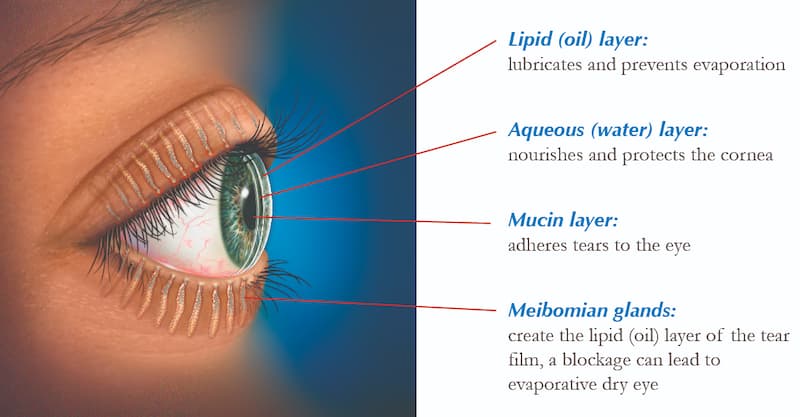

Dry eye symptoms, such as itchy, burning, or irritated eyes can be frustrating and may even interfere with day-to-day activities. Frequent dry eye symptoms may be caused by a common condition called dry eye syndrome or dry eye disease. Studies estimate that more than
Trusted Source
Farrand KF, Fridman M, Stillman IO, Schaumberg DA
Prevalence of Diagnosed Dry Eye Disease in the United States Among Adults Aged 18 Years and Older
Go to Source
16 million Americans
may suffer from dry eye syndrome.1
At The Eye Institute of Utah, our team of world-class ophthalmologists and optometrists includes dry eye experts who specialize in diagnosing and treating dry eye syndrome. We use advanced diagnostic tools to determine the cause of your dry eyes and we offer a variety of dry eye treatment options, so we can recommend an effective treatment plan that is tailored to give you relief from the irritation of chronic dry eyes.
With every blink, the surface of the eyes are moisturized by a tear film that washes away debris, prevents infection, and keeps your vision clear. The tear film consists of oils and lipids made in glands within your eyelids and a substance called mucin. Your eye health depends on a complex moisture balance that relies on producing enough tears and the right mix of lubricating oils.

Aqueous-deficient dry eye occurs when your eyes do not produce the right balance of water component in your tears. For patients who experience relatively mild dry eye, your doctor may prescribe over-the-counter artificial tears.
For patients that suffer from moderate to severe dry eye due to poor tear production, prescription eye drops called Restasis® may be recommended. Other options available to treat aqueous-deficient dry eye include punctal plugs or surgery to the tear drainage system. Your doctor will determine which combination of treatments will be most beneficial for you.
If you have evaporative dry eye, your eyes are likely suffering from a deficiency in the outer oil layer of the tear film. When the thin oil layer is depleted, the water layer of the tear film dries out and evaporates at a more rapid rate. Several factors can cause or contribute to evaporative dry eye including a common condition called meibomian gland dysfunction (MGD). The meibomian glands are the oil producing glands in your eye lids and MGD occurs when they become blocked.
Anyone can experience occasional dry eyes as a result of lifestyle factors such as frequent screen time or environmental factors such as dry, windy weather. There are
Trusted Source
American Academy of Ophthalmology
What is Dry Eye?
Go to Source
certain risk factors
that may increase your chances of developing dry eye syndrome, including:2
If you experience dry eye symptoms often, you should contact us to schedule an appointment. Dry eye syndrome can be diagnosed at a comprehensive eye exam with one of our experienced eye doctors.
What to Expect at Your Dry Eye Examination
Prior to your eye exam, please:
We will have you fill out a Dry Eye Questionnaire so we can better understand the severity and frequency of your dry eye symptoms. If you are seeking relief from chronic dry eye symptoms, our eye doctors can use several advanced diagnostic tools, including LipiView® Analysis and/or the TearLab® Osmolarity Test.
The LipiView® Ocular Surface Inferometer is an advanced imaging technology used to evaluate the layers of the tear film, the Meibomian glands and your unique blinking patterns. During your dry eye examination, we will perform a LipiView® Analysis to help determine if you have any imbalances in your tear film, which will help us determine the best treatment options for you.
The osmolarity levels (saltiness) of your tears can help diagnose dry eye disease and determine the severity of dry eye you have. The TearLab® Osmolarity System is used during your exam to determine your Osmolarity Score. A small, 50 nanoliter sample of your tears is analyzed by your doctor to determine your Osmolarity Score, which may range from 280 to 400. This quantifiable number is an indication of the severity of your dry eye and is a benchmark to track the effectiveness of treatments.
There are a range of dry eye treatment options available at The Eye Institute of Utah, including:
In addition to one or more of the above treatment options, your doctor may recommend blinking exercises, warm compresses, omega-3 fatty acid and flaxseed supplements. They can also give you tips to improve lid hygiene to give you the best improvement in your dry eye symptoms.
Learn more about dry eye treatment options
Certain advanced treatments may not be covered by insurance. The dry eye exam is typically covered and we will discuss your treatment options at your consultation appointment.
Many people are surprised to learn that eyes that tear or water constantly are actually very dry. Although excessive tearing seems like a contradiction, it is a very common symptom of dry eye. When your eyes are not retaining enough moisture due to either poor tear production, rapid tear evaporation, or issues with tear drainage, your eyes may begin producing an excess amount of tears to compensate.
The symptoms of chronic dry eyes are very irritating and can interfere with your ability to perform or enjoy regular activities. If left untreated, dry eyes can leave you susceptible to eye infections, corneal abrasions, or other serious eye problems.
1 Farrand KF, Fridman M, Stillman IO, Schaumberg DA. Prevalence of Diagnosed Dry Eye Disease in the United States Among Adults Aged 18 Years and Older. Am J Ophthalmol 2017;182:90-8
2 American Academy of Ophthalmology. What is Dry Eye? Available: https://www.aao.org/eye-health/diseases/what-is-dry-eye Accessed July 12, 2021
Page Updated:
The Eye Institute of Utah Doctors have either authored or reviewed and approved this content.